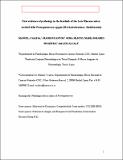Por favor, use este identificador para citar o enlazar a este item:
http://hdl.handle.net/10261/124731COMPARTIR / EXPORTAR:
 SHARE SHARE
 CORE
BASE CORE
BASE
|
|
| Visualizar otros formatos: MARC | Dublin Core | RDF | ORE | MODS | METS | DIDL | DATACITE | |

| Campo DC | Valor | Lengua/Idioma |
|---|---|---|
| dc.contributor.author | Salesa, Manuel J. | - |
| dc.contributor.author | Antón, Mauricio | - |
| dc.contributor.author | Siliceo, Gema | - |
| dc.contributor.author | Pesquero, María Dolores | - |
| dc.contributor.author | Alcalá, Luis | - |
| dc.date.issued | 2014-03-03 | - |
| dc.identifier | doi: 10.1002/ar.22902 | - |
| dc.identifier | e-issn: 1932-8494 | - |
| dc.identifier | issn: 1932-8486 | - |
| dc.identifier.citation | Anatomical Record - Advan in Integr Anatomy and Evol Biology 297(6): 1090-1095 (2014) | - |
| dc.identifier.uri | http://hdl.handle.net/10261/124731 | - |
| dc.description.abstract | We examined the first evidence of pathology in the forelimb of the primitive saber-toothed felid Promegantereon ogygia, observed in a radius from the late Miocene (Vallesian, MN 10) site of La Roma 2 (Teruel, Spain). This fossil is the first evidence of a member of the Machairodontinae in this locality, and the first fossil of this species found in the Miocene basin of Teruel. The radius shows an exostosis shaped as a rough and wide bony crest probably caused by the lesion and posterior ossification of part of the tendon of the muscle abductor pollicis longus, an important extensor and abductor of the thumb. The lesion was probably due to a tearing or to high levels of exertion experienced by this muscle over a relatively long time, a general type of lesion also observed in other vertebrate fossils. With saber-toothed felids using their thumbs to immobilize prey during the hunt, the studied lesion probably affected in a significant manner the predatory abilities of the animal, causing at least a decrease in its hunting success rate. Anat Rec, 297:1090-1095, 2014. © 2014 Wiley Periodicals, Inc. | - |
| dc.description.sponsorship | This study is part of the research project CGL2008-00034 (Dirección General de Investigación, MEC). | - |
| dc.publisher | John Wiley & Sons | - |
| dc.relation.isversionof | Postprint | - |
| dc.rights | openAccess | - |
| dc.title | First evidence of pathology in the forelimb of the Late Miocene saber-toothed felid Promegantereon ogygia (Machairodontinae, Smilodontini) | - |
| dc.type | artículo | - |
| dc.identifier.doi | 10.1002/ar.22902 | - |
| dc.date.updated | 2015-11-10T10:01:42Z | - |
| dc.description.version | Peer Reviewed | - |
| dc.language.rfc3066 | eng | - |
| dc.rights.license | http://creativecommons.org/licenses/by/4.0/ | - |
| dc.relation.csic | Sí | - |
| dc.type.coar | http://purl.org/coar/resource_type/c_6501 | es_ES |
| item.fulltext | With Fulltext | - |
| item.openairecristype | http://purl.org/coar/resource_type/c_18cf | - |
| item.openairetype | artículo | - |
| item.cerifentitytype | Publications | - |
| item.grantfulltext | open | - |
| Aparece en las colecciones: | (MNCN) Artículos | |
Ficheros en este ítem:
| Fichero | Descripción | Tamaño | Formato | |
|---|---|---|---|---|
| Anatom Rec 297(6) 1090-1095 (2014) POSTPRINT.pdf | 2,09 MB | Adobe PDF |  Visualizar/Abrir |
CORE Recommender
SCOPUSTM
Citations
8
checked on 29-mar-2024
WEB OF SCIENCETM
Citations
6
checked on 24-feb-2024
Page view(s)
271
checked on 23-abr-2024
Download(s)
358
checked on 23-abr-2024
Google ScholarTM
Check
Altmetric
Altmetric
Este item está licenciado bajo una Licencia Creative Commons

